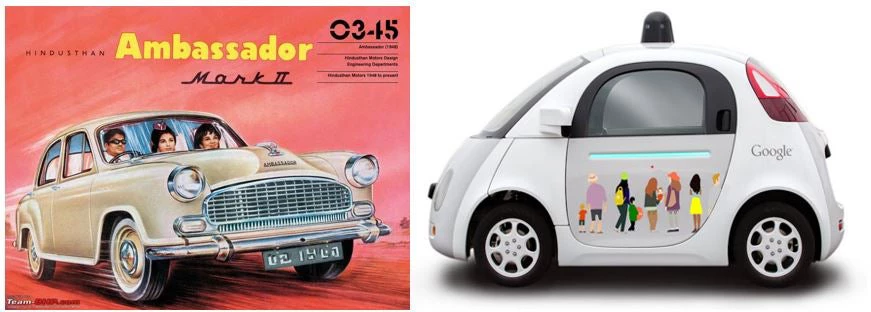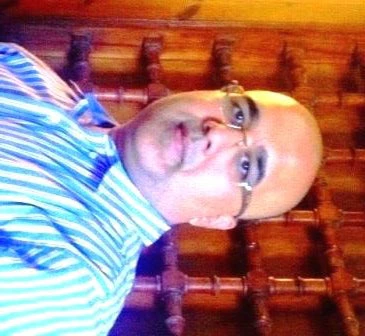
The 70’s were waning and the loudspeaker was still blaring disco. The celebration in this middle class New Delhi neighborhood was noticeable. It was a party to welcome a new car, which like a new bride was decked with marigold garlands. Neighbors had joined the obligatory prayer ceremony in anticipation of a festive lunch. The auspicious coconut was broken and a plump lemon crushed under the tire to ward off evil jealous eyes. A child birth in this neighborhood was rarely celebrated as grandly. Maybe unlike a baby, the car had come after ten long years of excruciating wait and bribes.
Below the garish decorations, the car was technologically from the World War era. Adorned with cheap interiors. It was pretentiously named “Ambassador” and for 50 years, it reigned as the queen of Indian roads. It should have been named “liberator” instead. It liberated the aspiring middle class from the indignities of soul crushing congestion and the curling stench of the Delhi Transport Corporation buses.
When it came to public transportation in pre-1990s India, the bus was a metaphor for socialism, where everyone riding was equal and equally miserable. The car on other hand signified individual liberty, a symbol of capitalism. This fundamental struggle and human desire to balance liberty and equality has historically and philosophically defined the debate on the preferred mode of transportation, Public-Private Partnerships and the role of Information and Communication Technologies.
In America, the historic debate on the roles of the public and private sectors in transport can be attributed to what Alexis de Tocqueville, the famous French historian saw in 1835: an inherent conflict between government driving equality and the private sector driving liberty. The first manifestation of this conflict can be seen in the private toll road building eras from 1792 to 1845, where there were 1562 toll road incorporations in the eastern states. The toll roads were the primary means for building roads till 1902. A massive amount of private money was poured into the toll roads. In 1830, it was 6.15% of nation’s GDP. The result unfortunately was a road system that catered to rich areas and mud paths for the rest of the country. The private enterprise had failed, as liberty for few at the high cost of un-equality for the rest was unacceptable and uneconomical.
The introduction of the gas tax paved the way for the government-driven construction of the Interstate system, with the majority of its mileage going through poor and sparsely inhabited areas. This massive infrastructure program unleashed economic opportunities in the heartland and brought unimaginable prosperity. It also demonstrated the effectiveness of infrastructure investment as a powerful tool for development and poverty reduction. This federally planned and executed system would have shocked the nation’s founder, who believed in a very restricted federal role. The government-built Interstate system ironically became the symbol of liberty, a conduit for individualism, inspiration for so many popular songs and movies, making icons out of cars and machines.
The Ambassador car, just like its cousin Lada from Eastern Europe, predominantly sits in museums and junk yards, and the newly rich middle class has hundreds of domestic and foreign cars to choose from. The headlines these days routinely scream about traffic Armageddon, meanwhile the METRO rail glides by with people enjoying an air-conditioned ride in the sweltering 45-degree Celsius Delhi heat. Now we are equally miserable in our separate cars, while predominantly liberated in public transportation together.
Our rigid understanding of liberty, equality, and the roles of government and the private sector has dramatically transformed. This is due to the massive technological changes that have taken place in our world over the last 30 years. The introduction of better design and ICT advancement have ensured that public transport could provide personal comfort, security, reliability, responsiveness, and ease of use, liberating users from the drudgery faced by the earlier generations. The video cameras and surveillance help reduce the incidents of criminality. A proper seat assignment system ensures against overcrowding in rail cars. A good climate control system ensures that more people sit inside the bus rather than on its roof. In the 80’s, it was normal to stand in line for 6 to 8 hours at an Indian railway station to reserve a seat. It now takes only a couple of clicks on a website to get reservation in any train of your choice.
The development community is still stuck in the old territorial tug of war between roads and public transit, as to which is green, which is dirty, which provides more public goods, which doesn’t, and so on. The train has left the station on these old ways of thinking. The historical pursuit of finding a balance between liberty and equality in transport modes is now not about modes but about technology. A road with emission-free vehicles on it could become greener than public transit service run with old buses. METRO could be more liberating and empowering than a car. The future strategic choices are not limited to road, rail, metro, buses, and the modal stereotypes associated with them.
The human pursuit to balance equal access and personal liberty in transportation will be achieved through the next generation of multi-modalism, driven by technology. I would like to name it “Techno- modalism”. The strategic techno-modal planners of tomorrow will transport us through Hyperloop, next generation of magnetic levitation technology, self-driven cars, automated freight lines, roads paved with photovoltaic cells and other means we haven’t even thought of. In 30 years, we will look back at our current modal debates, the same way our kids look at our brick size cell phones from the 90s. Let’s welcome Techno-modalism to our future.


Join the Conversation